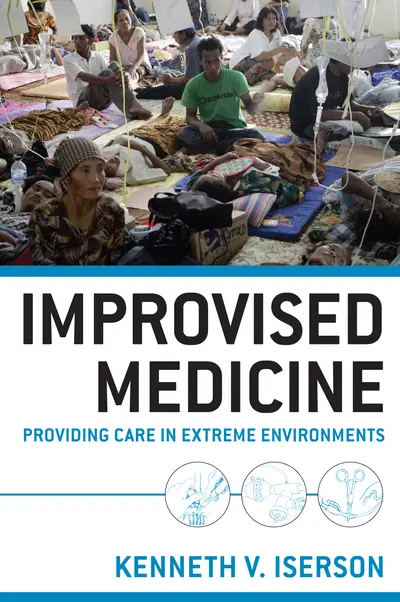My Account Details

ISBN10: 0071754970 | ISBN13: 9780071754972

Step 1 . Download Adobe Digital Editions to your PC or Mac desktop/laptop.
Step 2. Register and authorize your Adobe ID (optional). To access your eBook on multiple devices, first create an Adobe ID at account.adobe.com. Then, open Adobe Digital Editions, go to the Help menu, and select "Authorize Computer" to link your Adobe ID.
Step 3. Open Your eBook. Use Adobe Digital Editions to open the file. If the eBook doesn’t open, contact customer service for assistance.
Publisher's Note: Products purchased from Third Party sellers are not guaranteed by the publisher for quality, authenticity, or access to any online entitlements included with the product. Deliver quality healthcare in the most challenging field conditions "Dr Iserson has given us a most remarkable book. Many readers may be familiar with David Werner's lay healthworker book, Where There Is No Doctor; this new volume could be titled Where There Is a Doctor–But No Stuff. Drawing from his experience providing care in international, wilderness, and disaster settings, he has compiled an impressive collection of bare-bones equipment and work-around strategies to provide the best possible care in resource-poor settings. While presenting many creative examples, the purpose of the book is not to offer an exhaustive list of solutions to missing resource challenges but to inspire creativity in readers who may find themselves needing to improvise." -- Family Medicine Full of practical clinical pearls and proven strategies, this indispensible guide shows you how to operate outside your comfort zone and devise effective treatment solutions when the traditional tools (medications, equipment, and staff) are unavailable—or when you need to provide care outside of your specialty. Improvised Medicine is a must for anyone who plans to work in global, disaster, or other resource-poor settings. FEATURES: Simple-to-follow directions, diagrams, and illustrations describe practical techniques and the improvised equipment necessary to provide quality care during crises. Contains improvisations in anesthesia and airway management, dentistry, gynecology/obstetrics, infectious disease/laboratory diagnosis, internal medicine, otolaryngology, pediatrics and malnutrition, orthopedics, psychiatry, and surgery. Also includes basic disaster communication techniques, post-disaster forensics, a model hospital disaster plan, and innovative patient-transport methods. LEARN HOW TO: Make an endotracheal tube in seconds Perform digital-oral and blind-nasotracheal intubations Make plaster bandages for splints/casts Give open-drop ether, ketamine drips, and halothane Use subcutaneous/intraperitoneal rehydration/transfusion Make ORS and standard nutrition formulas Clean, disinfect, and sterilize equipment for reuse Warm blood units in seconds inexpensively Take/view stereoscopic x-rays with standard equipment Quickly and easily stop postpartum hemorrhage Fashion surgical equipment from common items Evacuate patients easily for high-rise hospitals Make esophageal and precordial stethoscopes Quickly improvise a saline lock Make ECG electrode/defibrillator pads and ultrasound gel
1: What is Improvised Medicine?
2: What Are Resource-Poor Situations?
Section II. Basic Needs
3: Communication
4: Preventive Medicine/Public Health
5: Basic Equipment
6: Cleaning and Reusing Equipment
Section III: Patient Assessment/Stabilization
7: Vital Signs and Triage
8: Airway
9: Breathing/Pulmonary
10: Circulation/Cardiovascular
11: Dehydration/Rehydration
12: Medications/Pharmacy/Envenomations
13: Analgesics
14: Anesthesia—Local and Regional
15: Sedation and General Anesthesia
16: Anesthesia: Ketamine, Ether and Halothane
17: Transfusion
18: Radiology/Imaging
19: Laboratory
20: Patient Transport/Evacuations
Section IV: Surgical Interventions
21: Surgery/Trauma
22: Wounds and Burns
23: Dental Diagnosis, Equipment, Blocks and Treatment
24: Dental: Fillings, Extractions and Trauma
25: Otolaryngology (ENT)
26: Neurology/Neurosurgery
27: Ophthalmology
28: Obstetrics/Gynecology
29: Orthopedics
30: Urology
Section V: Non-Surgical Interventions
31: Gastroenterology
32: Infectious Diseases
33: Malnutrition
34: Pediatrics and Neonatal
35: Psychiatry
36: Rehabilitation
37: Death and Survivors
Section VI: Appendices
Appendix 1: Hospital Disaster Plan
Appendix 2: Medical Kits
Need support? We're here to help - Get real-world support and resources every step of the way.